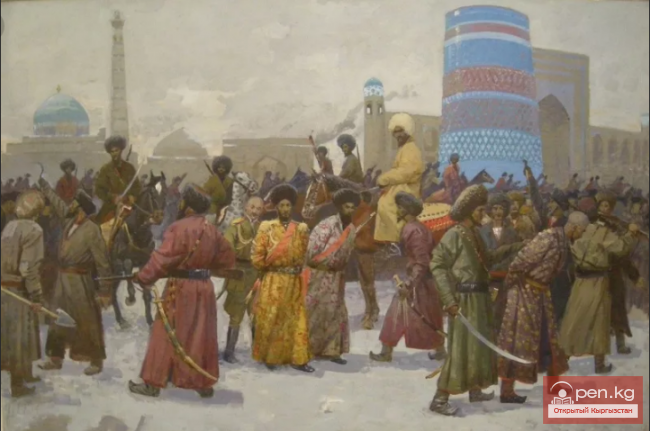
The clan leaders of many southern Kyrgyz tribes, not connected with the court clique, began to contemplate a general uprising capable of overthrowing Khudoyar. However, they needed a leader with a loud name, necessarily from the ruling Ming dynasty - this was a long-standing tradition. When the true heir to the throne - Pulat-bek, who was leading a miserable existence as a student at a madrasa, refused this mission, a substitute was found, the very same mullah Iskhak Hasan-ulu. In the spring of 1873, he was proclaimed khan - "raised on white felt."
The conclusion of this noble adventure is known. On March 1, 1876, in the market square of Margilan, in the presence of a large crowd, Pulat-khan and several other leaders of the rebels were hanged by order of the Russian authorities.
The herald read the sentence in Russian and the local languages...
What attracted Pulat-khan, Abdullabek, and many other leaders of the Kyrgyz tribes? According to historians A. Kakeev and V. Ploskiy, mullah Iskhak "was not the sole leader of the uprising, but shared power with the leaders of individual rebel detachments, among whom the Andijan Kyrgyz Mamyr Mergenov and the Chatkal Kyrgyz Momun Shamurzakov were the most well-known." Most likely, it was because of the proximity of his tribesmen to the leader of the rebels that Abdullabek hoped that in the event of a successful uprising, power could be concentrated in the hands of the Kyrgyz in the khanate. It should be added that similar hopes were cherished by many clan leaders of the Kyrgyz.
Abdullabek himself soon after the defeat of the Kokand Khanate undertook a pilgrimage to Mecca, where he passed away.
The body of the deceased, according to Kyrgyz custom, was transported to Alai and buried with honors in the family cemetery in Gulcha.
It should be emphasized that for the first time, representatives of a non-Islamic civilization, i.e., "infidels," found themselves in power here.
It was quite difficult for the Russians to maintain influence, considering the power of the nobility and the Islamic clergy, who had lost a significant part of their privileges with the arrival of the Russians. On the other hand, the previous way of life of the subjects of the khanate had accustomed them to regard disorder as something inevitable. In an atmosphere of uncertainty about tomorrow, which affected not only ordinary residents but even the offspring of the ruling dynasty, lawlessness and abuse of power were commonplace. Therefore, the establishment of European-style governance with the supremacy of the law was something unusual for the former subjects of the khanate.
However, the beneficial influence of stability and law and order soon made itself felt: despite the restrictions on rights, the prosperity of the local aristocracy steadily grew, which became a decisive factor in reconciling the local population with the newcomers.
By the way, the futility and fruitlessness of the policy of those who supported resistance to the Russian authorities was evidenced by the further fate of Kurmandjan Abdullabek's son, who pursued precisely such a policy.
As for the alternative to rapprochement between the southern Kyrgyz and Russia, which allegedly existed, many truly competent historians in this matter completely deny it. Judging by the testimony of many documents, the local peoples could hardly have created their own sovereign states at that time. Any such attempts would have ended in conflicts equally devastating for all ethnic groups living in Central Asia. It can be said that the sad fate of Abdullabek, a loyal companion of Pulat-khan, serves as an instructive example of such a possible scenario at that time.
Ambitions and the end of Pulat-khan - the "Alai Prince"








































